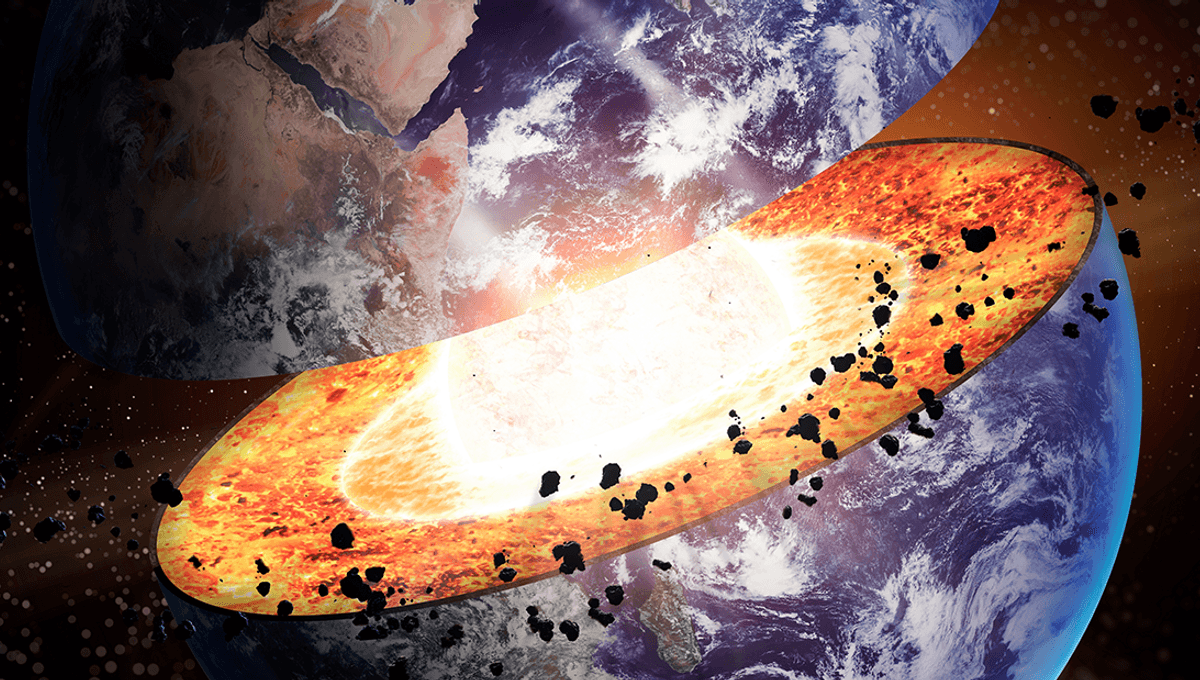
Deep beneath the surface of the Earth, there is a massive reservoir of water, estimated to contain three times the amount of water of all the oceans on our surface. A new study suggests how it might have ended up there, trapped in the Earth’s transition zone.
In 2014, a team from the US used 2,000 seismometers to study seismic waves from over 500 earthquakes. By examining the speed of the waves at different depths, the team was able to determine what kind of rocks the waves traveled through before reaching the sensors. They found that some 700 kilometers (400 miles) below our feet in the “transition zone” between the lower mantle and the upper mantle was a rock called ringwoodite.
Ringwoodite only forms under the intense pressure found towards the center of our planet. Only one sample from within the Earth – it has also been found in meteorites – has been discovered, trapped inside a tiny diamond. Ringwoodite contains water, not as liquid but trapped inside the molecular structure of the minerals.
“The ringwoodite is like a sponge, soaking up water. There is something very special about the crystal structure of ringwoodite that allows it to attract hydrogen and trap water,” geophysicist Steve Jacobsen explained in a statement at the time. “This mineral can contain a lot of water under conditions of the deep mantle.”
Previous experiments suggested that ringwoodite can contain up to 1.5 percent water, and the seismic waves detected were consistent with the rock below our feet containing water. The team estimated that if just 1 percent of the rock in the transition zone is water, that would mean it contains three times more water than all the oceans on Earth’s surface. This fit with their results.
“If there is a substantial amount of H2O in the transition zone, then some melting should take place in areas where there is flow into the lower mantle,” seismologist Brandon Schmandt said, “and that is consistent with what we found.”
Jacobsen believes that the study contributes to evidence that Earth’s water “came from within,” he told New Scientist. “I think we are finally seeing evidence for a whole-Earth water cycle, which may help explain the vast amount of liquid water on the surface of our habitable planet,” Jacobsen added in the statement. “Scientists have been looking for this missing deep water for decades.”
While the evidence appears to show that there is a lot of water stored in the mantle transition zone (MTZ), there is still debate about how it got there, either being a primordial source within the Earth, or making its way down into the Earth from the surface.
In the new study, researchers looked at samples taken from the Emeishan Large Igneous Province in southern China, which has been linked to mantle plume activity. The team looked at heavy boron isotopes within the rock, finding that the levels were outside those in known mantle compositions, and more similar to those found in slab serpentinites – metamorphosed rocks that are part of a subducting tectonic plate.
“Our results suggest that subduction of serpentinized oceanic lithospheric mantle can transport considerable amounts of water into the Earth’s interior, leading to localized hydration of the deep mantle, probably at the mantle transition zone,” the team explains in their paper. “This water is then captured by the upwelling of deeply rooted plume material and recycled back to the Earth’s surface.”
While it is too far to suggest that this is where all of the Earth’s inner water came from, it does provide evidence that it can be subducted into the Earth as the crust is subducted into the Earth, only to be recycled again on geological timescales. More data, perhaps from elsewhere around the world, is needed to delve further into the mystery.
“Identifying modern analogues is challenging, because they must satisfy two critical criteria: a prolonged cold slab subduction in the region and subsequent ascent of a mantle plume behind the trench,” the team explains.
“One potential modern analogue may be the Columbia River LIP [large igneous province], where the Miocene CFBs [continental flood basalts] are thought to be intimately linked to the Yellowstone mantle plume. Prior to the Columbia River LIP eruption, the Farallon oceanic slab underwent prolonged subduction beneath the North American plate, possibly extending into the mantle transition zone. Therefore, similar heavy boron isotope signatures may be expected to occur in the Columbia River CFBs.”
The study is published in Communications Earth & Environment.
Source Link: A Vast Ocean Of Water May Be Trapped In The Transition Zone Beneath Our Feet